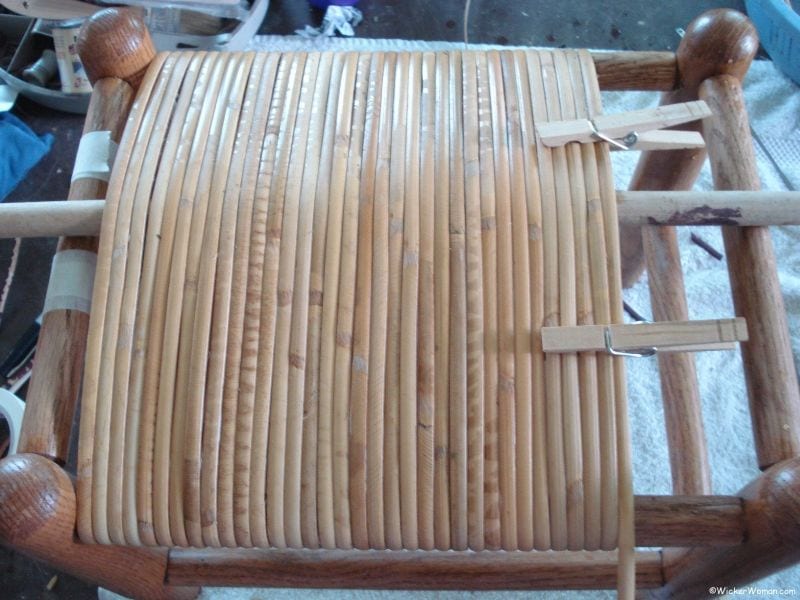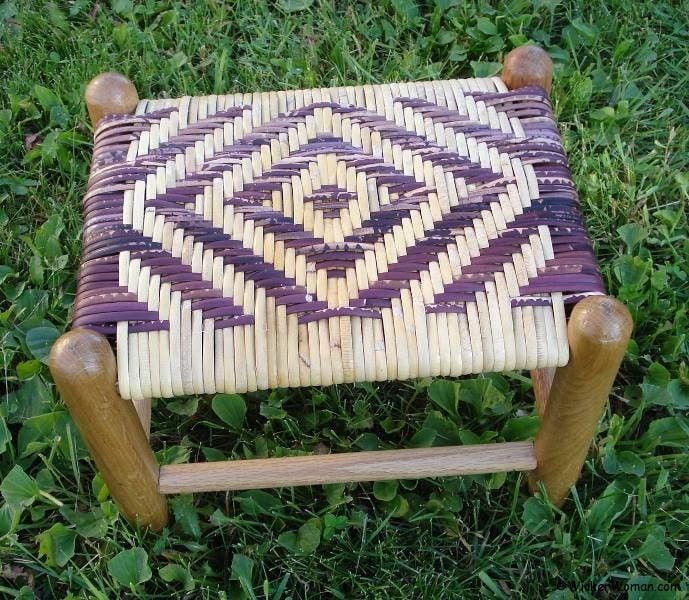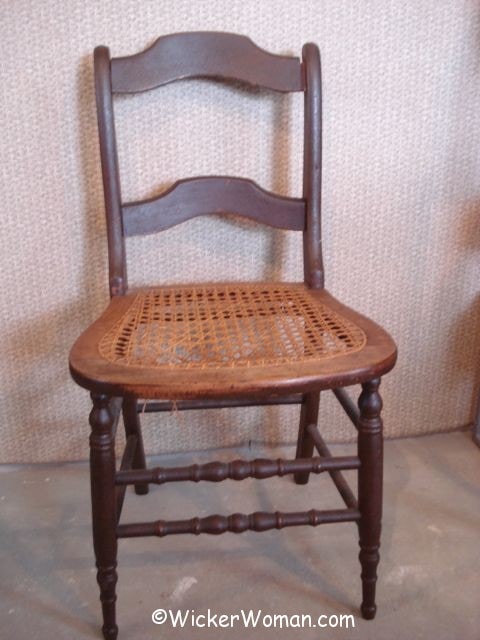Wednesday Wicker Wisdom
Have you ever woven on a binder cane or porch cane seat and gotten to the last few rows and found that it’s nearly impossible to get those rows finished because the previous weaving is too tight?
Want to throw up your hands in disgust and you are frustrated beyond belief?
Or maybe a binder cord chair has come in for repairs and the front seat dowel is so bowed (or it’s broken), that it needs to be replaced?
I bet some up-tight weaver must have woven that seat! Or they didn’t know the hint I’m sharing with you today.


Have you ever seen the back of a porch cane rocker that has both sidebars so bowed that it looks lopsided and strange, contorted all out of proper shape? Read on, cuz I have the solution to your pressing problem!
Use tension rods on a binder cane seat
Well, here’s the answer that will solve all your problems weaving that porch cane chair seat or back!
Use one or two round tension rod wooden dowels when you set up your warp or foundation strands!

Put the wooden dowel rod (that you can purchase from any hardware store or big box store), horizontally across the center of the seat before beginning to weave.
Depending on how tight a weaver you are, you might want to use two rods that are a smaller dimension, instead of just the one.
Place one rod horizontally across the top of the seat and one across the bottom.
Attach the rods on each side outside of the stool opening, top and bottom, using twist ties.
Experiment on a few footstools before actually working on a customer’s chair though, to make certain your tension is right.
You don’t want it too tight, nor too loose. Just like baby bear in Goldilocks, the tension should be “just right.”

First attach a very long strand of pre-soaked wide binding cane to the inside of the left rail, using some masking tape or small upholstery tacks.
Bring the strand from the bottom, around the back rail and up to the top.
Make sure the shiny, glossy “right” side of the cane is facing upward.
Then begin setting up your warp or foundation strands from back to front, taking care that you are going OVER the tension rod each time as you pull the strand toward you.
Take care that strands are butted up next to the left corner posts and are all laying side-by-side with no overlapping.

Make sure to pull the cane strands taught, but not tight as you go around the tension rod and the seat framework.
Keep the tension the same each time, otherwise, you will have bulges and an inconsistent lumpy seat at the front rail.
Continue setting up your warp (vertical strands) in this manner until you have filled the seat to the right corner posts.
Then begin weaving the horizontal strands, top and bottom sides of the stool.
I use a herringbone twill of 3×3, over three, under three. And on the bottom I typically use over under 4×4 twill pattern.

When you have woven about half way through the seat with the horizontal strands then you can pull out those tension rods.
Because by then, they have served their purpose by giving you ample slack to finish weaving those last few rows without problems!

And now you can enjoy your completed wide binding cane chair or footstool, with the help and assistance of your wide binding cane tension rods.
No more pulling out all your hair in frustration during the weaving process! Whaooo! You did it!
What method do you use to make the weaving easier on a similar porch cane stool or chair seat? Please leave your comment below.


What are your thoughts about this resource article page?
Leave your comments below and share with your social networks!
~~Live Well, Laugh Often, Love Much ~~
Happy Weaving, until next time!





Hi Cathryn,
What is the usual vintage of a chair with woven binder cane?
Thank you,
Teena Stauffer
Teena,
Here in the States, we’ve always used binder cane on the hole-to-hole chair seats, to finish off the edges and cover the holes, so it goes back to the mid to late 1700s.
Now, if you are talking about chair seats entirely woven with binder cane as are the porch cane rockers and school and office chairs, those became extremely popular in the mid-1800s.
But you can’t date the chairs strictly by the pattern and material since the binder cane seats have been woven throughout the centuries.
Hope that helps and answers your question, let me know if you have any more.
Wow! What timing! I just did my first chair. Used the old caning as a sample. I made SO many mistakes. Not satisfied….
I have 2 early 18th century (1720ish)chairs to do. They both have rotted rush seats, but decided to use 5/8 wide flat caning. These will be handed down so I want them nice. Again, I need help. Tips please.
Thank you
Bob
Congratulations on weaving your very first chair seat! Just a note of caution here though, it’s never a good idea to use the old seat as a pattern when you are learning how to weave since many, many weavers do it wrong in a lot of cases. It’s best to learn from a reputable book, find the ones I recommend on the Seatweaving FAQ page, or in a class from a pro. You didn’t mention what state you live in but check with your local community education and folk schools in your area and also on my National Furniture Repair Directory™ to find a class. The SeatWeavers’ Guild, Inc.® also has a list of their members that offer classes all across the country.
Great tip, I’ve used it on seats for a long time. I am a pretty tight weaver and it really helps out.
Question – how does it help with the bowed back rails? Do you run the warp horizontally on the back?
Yes Joe, that’s one way to weave the backs on porch cane chairs, putting the tension rods in vertically, warping horizontally and then weaving vertically from one side or the other. You would need to position the rocker or chair so you could stand or side on the long side of the back and do your weaving from the side that’s closest to your body.
Or you can put two small dimension rods horizontally on the back rails and then put your warp in from top to bottom rails. Then do your actual weaving horizontally, as in the photos on the blog post. Doesn’t really matter too much, just what’s comfortable for you.
I also find that I have more control over the weaving and packing the rows, if I begin weaving as close to my body as possible, then it’s a simple matter of pulling toward me on each row as I go and packing the rows in so there’s no gaps between rows.
It’s funny I have done this dowel thing across the seat for 30+ yrs, because the first one I did, was exactly uneven in the front. The thing about caning, is there are so many tricks of the trade people have to learn. You can also lay a ruler across the hand cane seat and put your first step across it, to get the seat perfect:)
Oh me too Dottie, I’ve used this trick for over 35 years now, but find that there are still folks that have never heard of using the tension rods to make their weaving easier! Go figure! And since it was mentioned a while ago on the Chair Caning Forum, I thought I’d make a blog post about it again. Personally, I never use the flat rulers or paint sticks, because I don’t think they add enough “height” or room as you get with using either one or two round dowels. Always seemed like a waste of time to use the flat tension rods, in my opinion. But to each his own, right?